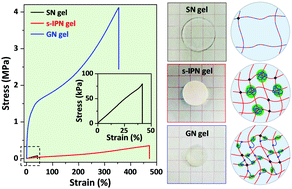Synergic influences of network topologies and associative interactions on the microstructures and bulk performances of hydrogels†
Abstract
Revealing the relationship between network topologies and mechanical properties of hydrogels is fundamental yet challenging in the design of tough soft materials. Here, we report a series of hydrogels using N-isopropyl acrylamide (NIPAm) and acrylic acid (AAc) as the basic units to form a single network of the copolymer, a semi-interpenetrated network of two homopolymers, and a grafted network with homopolymer chains anchored on another homopolymer network, to investigate the influence of network architectures on the mechanical properties and thermal responses of the gels. We found that the properties of the gels are also significantly influenced by the formation of hydrogen bonds between poly(N-isopropyl acrylamide) (PNIPAm) and poly(acrylic acid) (PAAc) segments. The gels with the single network of poly(NIPAm-co-AAc) are mechanically weak due to the low efficiency for forming robust hydrogen bonds, while micro-segregated domains are formed in the hydrogels with a semi-interpenetrated network structure due to the formation of inter-chain hydrogen bonds that favors energy dissipation and toughening of the gels. On the other hand, dense hydrogen bonds form between the grafted PNIPAm chains and the PAAc network, resulting in nano-segregated domains and excellent mechanical properties of the gels. The hydrogels with the grafted network structure exhibit a more repeatable response to temperature than those with the semi-interpenetrated network structure due to the relatively stable hydrogen-bond network. The comparison of the mechanical properties and thermal stability of the hydrogels with the same composition but different topological networks should be informative for engineering hydrogel properties or functions by tailoring the network structures.



 Please wait while we load your content...
Please wait while we load your content...